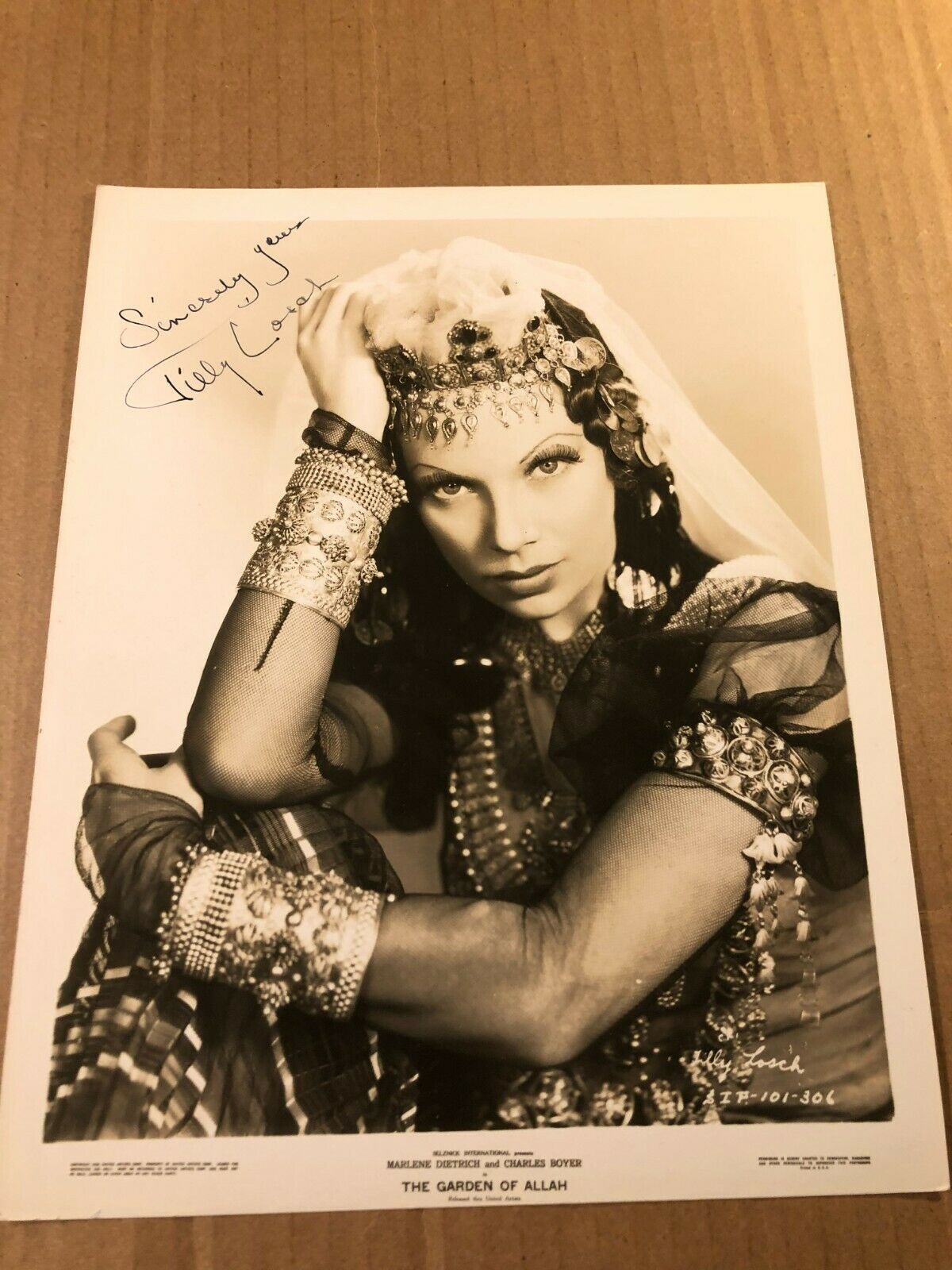-40%
Tilly Losch Extremely Rare Very Early Autographed 8/10 Photo '36 Garden Of Allah
$ 79.19
- Description
- Size Guide
Description
Here is an extremely rare very early vintage original autographed 8" by 10" photo of actress, dancer, choreographer, and painter Tilly Losch, from 1936, one of her most famous roles, Irina in The Garden of Allah. Tilly Losch was born on November 15, 1903 in Vienna, Austria-Hungary as Ottilie Ethel Losch. She is known for her work on The Garden of Allah (1936), Backstage (1937) and The Good Earth (1937). She was married to Henry Herbert, 6th Earl of Carnarvon and Edward James. Trained in dance at the Vienna Imperial Opera ballet school at age six and became a full member of the ballet corps at age 15. She made her professional debut and reputation, however, dancing Viennese waltzes. Dance partners included Fred Astaire and Harald Kreutzberg. F
ollowing a severe bout of depression, she turned to painting for self-expression and exhibited her work for a long period of time.
Chief ballerina to George Balanchine.
Second husband was the Earl of Camarvon, whose father discovered King Tut's tomb. This marriage gave her the title Lady Camarvon, an English countess.
She appeared in the original Broadway stage version of "The Band Wagon", in which she danced with Fred Astaire. Ginger Rogers met Astaire in New York in the early 1930s and saw Astaire in the original stage production of the show. She was enraptured by his dancing with Tilly Losch, and she wrote: "If I had known that I was going to be Fred's partner in a matter of months, I would have paid closer attention to each move and pause".
She died on December 24, 1975 in New York City, New York, USA. Extremely rare.
Will ship worldwide. I always combine shipping on multiple orders.
Ottilie Ethel Leopoldine Herbert, Countess of Carnarvon (née Losch; November 15, 1903 – December 24, 1975), known professionally as Tilly Losch, was an Austrian dancer, choreographer, actress, and painter who lived and worked for most of her life in the United States and United Kingdom. Born in Vienna to a Jewish family, Losch studied ballet from childhood at the Vienna Opera, making her debut in 1913 in Louis Frappart's 1885 Wiener Walzer. She became a member of the corps de ballet on March 1, 1918 and a coryphee three years later. Her first solo role was the Chinese Lady Doll in Josef Hassreiter's Die Puppenfee. Ballet master Heinrich Kroeller and the Opera's co-director, composer Richard Strauss, promoted her to soloist on January 1, 1924. She danced prominently in new ballets by Kroeller, Georgi Kyaksht, and Nicola Guerra. Outside the Opera, Losch took modern dance class with Grete Wiesenthal and Mary Wigman, and performed dramatic and movement roles in Viennese theaters, at the Salzburg Festival and in Max Reinhardt's 1924 Berlin production of A Midsummer Night's Dream, also choreographing the William Shakespeare play. Losch resigned from the Vienna Opera on August 31, 1927, in order to work more with Reinhardt at the Salzburg Festival and in New York City. She also choreographed Reinhardt's Everyman and Danton's Death.
Losch made her London debut in 1928 in Cochran's production of Noël Coward's musical revue This Year of Grace, and over the course of the next few years, worked in London and New York as both a dancer and choreographer. In New York she danced in The Band Wagon with Fred and Adele Astaire in 1931. Reinhardt encouraged her to extend herself and believed she could also act; casting her in a 1932 London production of The Miracle, Losch's part was rewritten to provide her with the only spoken dialogue in the production (The Lord's Prayer) which she recited to dramatic effect.
Losch's first husband, the Anglo-American millionaire and surrealist arts patron Edward James, founded a ballet company for her – Les Ballets 1933, which performed in London and Paris. George Balanchine, whom she had met in Berlin in 1924 and who helped her with some of her choreography, was artistic director and the entire repertory was choreographed by him. Its most popular work was The 7 Deadly Sins with Kurt Weill's music and Bertolt Brecht's text. Losch danced the leading role (a dual figure) and Lotte Lenya sang it. Tom Mitford (the Hon. Thomas Mitford, brother of the Mitford sisters) was described as Tilly's regular lover during this marriage. Losch was divorced by James in 1934, after being accused by him of adultery with Prince Serge Obolensky, a Russian-American hotel executive; her countersuit, in which she made it clear that her husband was homosexual, failed.
A permanent reminder of Tilly Losch could be seen at Edward James' former home at Monkton, on his West Dean estate. Her "wet" footprints were woven into the carpet on the spiral staircase. As Tilly emerged from the bath, leaving behind a trail of wet footprints as she ascended the spiral stairs, Edward subsequently commissioned the carpet with the motif woven into it as a token of his love for her. After their divorce Edward moved the carpet to West Dean House (now West Dean College, where it can still be seen) replacing it at Monkton with a similar carpet made with his dog's footprint. Losch extended her work into drama, and achieved her greatest popularity in England. Her stage success led her into Hollywood films. She appeared in several screen productions including Limelight (1936), The Garden of Allah (1936), The Good Earth (1937), and Duel in the Sun (1946). Her choreography was seen in Song of Scheherazade (1947). Dissatisfied with supporting film roles, she continued working as a dancer and choreographer and acted on Broadway. Losch guested with Ballet Theatre in New York in a work by Antony Tudor and in London danced Léonide Massine choreography. Her best known conception was "The Hand Dance" (a collaboration with her Viennese colleague, Hedy Pfundmayr) which is featured in a short dance film by Norman Bel Geddes. Prominent choreographers who made roles for Losch include Sir Frederick Ashton, Fred Astaire, George Balanchine, Heinrich Kroeller, Leonide Massine, and Anthony Tudor.[4]
A severe clinical depression caused Losch to spend time in a sanatorium in Switzerland and abandon dance. It was during this time that she married Henry Herbert, 6th Earl of Carnarvon. Losch began painting, first in watercolors and then later in oils. Her earliest works were self-portraits, but she later created portraits of friends such as Anita Loos, Lotte Lenya, and Kurt Weill, and she received encouragement from Cecil Beaton. Carnarvon, aware of Losch's delicate health, sent her to the United States, where he perceived she would be safe from the growing danger of the war in Europe. She mounted her first exhibition in New York City in 1944, and was well received by critics; the prominent collector and museum founder Albert C. Barnes bought one of Losch's works from her Dutch debut show.
She later combined visual elements of dance into her paintings, and often placed her subjects on a backdrop that evoked scenes of the war in Europe. As her style of painting developed she won acclaim. Her works were eventually purchased by London's Tate and other galleries.
Losch's marriage to Carnarvon ended in divorce in 1947 and she commuted between London and New York City for the remainder of her life.

















